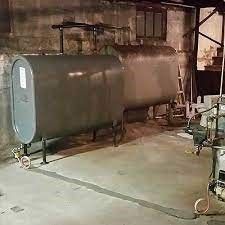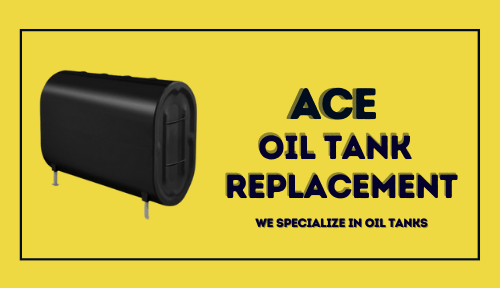Oil Tank Replacement Explained: 6 Essential Steps to Follow
Choosing a professional service for oil tank replacement can prevent leaks and environmental issues, offering peace of mind and long-term savings.
Replacing your old oil tank can seem scary, but it's key for your home's safety and efficiency. You might need to replace it if it's showing signs of wear or if it's getting old. We'll guide you through the six main steps for a smooth replacement, ensuring you follow environmental rules and feel secure.
Ace Oil Tank Replacement is here to help. They have over a decade of experience and focus on great customer service. They aim to make your oil tank replacement easy and worry-free. Call them at 413-241-6720 or visit their website to get started.
Key Takeaways
- Understand the signs of tank deterioration and the importance of timely replacement
- Familiarize yourself with local regulations and documentation requirements
- Prepare for the oil tank replacement process by conducting a pre-replacement assessment
- Ensure proper disposal and environmental compliance during the replacement process
- Weigh the pros and cons of underground vs. aboveground storage options
Understanding the Need for Oil Tank Replacement
As your oil tank gets older, it starts to break down. This can be dangerous and harm the environment. It's important to know when it's time to replace it to keep your oil system safe.
Signs of Tank Deterioration
Old oil tanks can show signs of wear like rust, corrosion, and damage. These problems can make the tank leak or even cause fires. It's key to check your tank often to catch these issues early.
Environmental and Safety Concerns
Leaks from old tanks can pollute soil and water. This is bad for the environment and can be expensive to clean up. It also raises the risk of fires or explosions. So, it's crucial to prevent spills and replace tanks on time.
Age-Related Replacement Guidelines
Experts say oil tanks should be replaced every 15-30 years. This depends on the tank's material and where it's located. Following these guidelines helps avoid big problems and keeps your tank working well for a long time.
| Tank Material | Recommended Replacement Interval |
|---|---|
| Steel | 15-20 years |
| Fiberglass | 20-30 years |
| Double-Walled Steel | 20-25 years |
"Proactive tank replacement is the best way to protect your property and the environment from the risks associated with aging oil storage systems."
Knowing when to replace your tank is important for safety and the environment. Call Ace Oil Tank Replacement at 413-241-6720 for more information on our tank replacement services.
Pre-Replacement Assessment and Planning
Before starting the oil tank replacement journey, a thorough assessment and planning are crucial. This step helps you make informed decisions and sets the stage for a successful project.
First, evaluate the current tank's condition. Look for signs of tank abandonment like corrosion, leaks, or damage. This will help decide if you need to replace the tank underground or aboveground.
If the tank is in bad shape, soil testing is next. This checks for any soil remediation needs. It ensures you meet local regulations and protect the area.
- Check the tank's condition and decide if it needs to be replaced.
- Do soil testing to find out if soil remediation is needed.
- Choose between aboveground tank replacement and underground tank replacement.
- Make a detailed plan for the replacement, including timelines, budget, and permits.
| Consideration | Underground Tank Replacement | Aboveground Tank Replacement |
|---|---|---|
| Installation Cost | Generally higher due to excavation and site preparation | Typically lower, as less extensive site work is required |
| Maintenance | Periodic inspections and monitoring for leaks | Easier access for visual inspections and maintenance |
| Longevity | Can have a longer lifespan if properly maintained | May have a slightly shorter lifespan compared to underground tanks |
By carefully assessing and planning, you can ensure a smooth oil tank replacement. The team at Ace Oil Tank Replacement is ready to help. Call us at 413-241-6720 to begin.
Professional Inspection and Permit Requirements
Replacing an old oil tank requires following local environmental regulations and getting the right permits. This might seem hard, but with the right help, you can do it smoothly and correctly.
Local Regulations and Documentation
First, learn about the environmental regulations in your area. Look into state and local laws, and what your local authorities need. You'll need permits and inspection reports to show you followed these rules.
Environmental Impact Assessment
An important part of replacing an oil tank is checking its environmental impact. This test finds risks and makes sure the replacement is safe for the environment. It might include tests of soil and groundwater to find any pollution.
Necessary Permits and Paperwork
Getting the right permits is key for oil tank replacement. You might need them from the fire department, building department, or environmental agency. These permits cover the new tank's installation and spill prevention steps.
| Permit Requirement | Typical Agency Involved |
|---|---|
| Installation Permit | Building Department |
| Fire Safety Permit | Fire Department |
| Environmental Compliance Permit | Environmental Protection Agency |
Dealing with local rules and permits can be tough. But, a pro like ACE Oil Tank Replacement (413-241-6720) can help a lot. They know how to guide you through each step, making sure your replacement is safe and follows the rules.
Oil Tank Replacement Process Overview
Replacing an oil tank is a detailed process that needs careful planning. It ensures a smooth transition. Whether it's for a tank installation, fuel tank replacement, or underground storage tank removal, the steps are similar.
- Assess the Existing Tank: First, inspect the current oil tank. Check its condition and decide if it needs to be replaced. Look for corrosion, leaks, or damage that shows it's time for a new one.
- Obtain Necessary Permits: Get the needed permits and approvals from local authorities before starting. This might include an environmental impact assessment and following regulations.
- Prepare the Site: Clear the area around the tank for safe access. This might mean digging for an underground tank or preparing for an aboveground one.
- Remove the Old Tank: Carefully remove the old tank, following safety and environmental rules for its disposal or decommissioning.
- Install the New Tank: With the site ready, put in the new tank. This could be an underground or aboveground tank, depending on the setup.
- Connect and Test the System: After installing the new tank, reconnect it to the fuel line and test it. This ensures it works right and is safe.
It's important to follow local rules and prioritize safety during the whole process. Work with experienced professionals for a successful tank installation, fuel tank replacement, or underground storage tank removal.
| Step | Description | Average Timeline |
|---|---|---|
| Site Assessment | Evaluate the existing tank and prepare the site | 1-2 days |
| Permit Acquisition | Obtain necessary permits and approvals | 2-4 weeks |
| Tank Removal | Safely disconnect and dispose of the old tank | 1-2 days |
| Tank Installation | Deliver and install the new tank | 1-2 days |
| System Reconnection | Connect the new tank to the fuel line and test the system | 1 day |
For professional help with your tank installation, fuel tank replacement, or underground storage tank removal needs, contact Ace Oil Tank Replacement at www.aceoiltankreplacement.com or call 413-241-6720.
Underground vs Aboveground Storage Options
When it's time to replace your old oil tank, you have two main choices: underground storage tanks (USTs) and aboveground storage tanks (ASTs). Each option has its own pros and cons. It's key to think about what you need before deciding.
Comparing Installation Costs
The cost to install underground and aboveground tanks differs a lot. Underground storage tank removal costs more because it needs digging, disposing of the old tank, and setting up the new UST. Aboveground tank replacement is cheaper upfront.
Maintenance Requirements
Thinking about maintenance is important when picking between underground and aboveground tanks. USTs need more detailed and often checks for spill prevention and leaks. This can raise maintenance costs over time. ASTs are easier to get to and maintain, making them a better choice for some.
Longevity Considerations
The lifespan of your oil tank is a big factor. USTs usually last 30 to 50 years with good care. ASTs, though, may not last as long, around 20 to 30 years, due to weather and corrosion.
| Feature | Underground Tanks | Aboveground Tanks |
|---|---|---|
| Installation Costs | Higher | Lower |
| Maintenance Requirements | More Complex | Easier |
| Longevity | 30-50 years | 20-30 years |
The choice between underground and aboveground tanks depends on your budget, needs, and preferences. For the best advice, talk to a professional like Ace Oil Tank Replacement at 413-241-6720.
Safe Disposal and Environmental Compliance
Replacing your old oil tank means you must follow strict rules for disposal and environmental care. The team at Ace Oil Tank Replacement knows how crucial it is to follow local and federal laws. We'll help you through the safe removal and disposal, making sure the environment is not harmed.
The old tank must be disposed of safely and responsibly. This might include cleaning the soil if there's been a leak. Our skilled technicians will work with you and local authorities to protect the environment. We'll take care of all the paperwork and permits needed to follow EPA and other laws.
At Ace Oil Tank Replacement, we're dedicated to protecting the environment. Our team will make sure your old tank is disposed of safely. This way, the soil, groundwater, and ecosystems around it stay safe. By choosing us, you know your project will meet all environmental laws. Call us at 413-241-6720 or visit our website to learn more about our services.
Oil Tank Disposal and Environmental Compliance
| Disposal Checklist | Compliance Requirements |
|---|---|
| Safe tank removal | EPA regulations |
| Proper disposal of tank and contents | Local environmental guidelines |
| Soil remediation (if necessary) | Necessary permits and documentation |
FAQ
What are the signs that my oil tank needs to be replaced?
Signs your oil tank needs a replacement include rust, leaks, or being over 15-20 years old. Regular checks and watching for damage are key to keeping your tank safe and working well.
Do I need a permit to replace my oil tank?
Yes, you'll need a permit to replace your oil tank. Check with your local government for the exact requirements. They'll tell you what documents and inspections you need.
How do I properly dispose of my old oil tank?
Disposing of an old oil tank right is important for the environment. It must be removed by a pro, and the soil tested. The tank should then be cleaned and recycled or disposed of legally.
What's the difference between underground and aboveground oil tank options?
Underground tanks are hidden but harder to install and risk leaks. Aboveground tanks are cheaper and easier to check and maintain.
How can I ensure my new oil tank is properly installed?
Get a pro with a license to install your new tank. They'll get the permits, prepare the site, and test it. This ensures it's safe and meets all rules.
What should I do if my oil tank has leaked or caused soil contamination?
If you think your tank has leaked, call a pro environmental cleanup company right away. They'll check the damage and clean it up to meet regulations.


